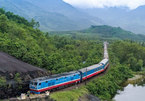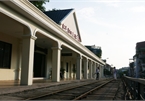 |
| A train test runs on the Cat Linh-Ha Dong urban rail line in downtown Hanoi. Several financial irregularities have been found in the project – PHOTO: TNO |
The SAV recently announced the results of its inspection into the construction, management and use of investment capital in the railway project, whose main contractor is China Railway Sixth Group Co. Ltd.
The inspectors found several violations in the planning, appraisal and approval of its investment and capital adjustment, and the signing of the project’s contracts.
The project’s total investment ballooned by 205% from the original estimate of some VND8.7 trillion (US$552.8 million) to more than VND18 trillion (US$868 million), including VND13.8 trillion, or US$670 million, in loans from China.
When the Ministry of Transport decided to raise the project’s total cost in February 2016, it failed to report the adjustment to the prime minister to gain the National Assembly’s approval.
This conduct went against the Law on Public Investment and a resolution of the legislative body, according to the SAV.
As of late June 2018, the investor claimed to have disbursed some VND11.3 trillion for the project, but the SAV found that the actual figure was some VND8.6 trillion.
The difference of VND2.6 trillion was ascribed to miscalculations in construction volume and pricing, among other things.
For example, the investment in equipment and train carriages rose by a whopping VND3.1 trillion, of which car costs rose by 227% to some VND2.7 trillion.
The ministry was found to have approved an equipment appendix in the project’s Engineering, Procurement and Construction (EPC) contract at US$178.7 million, which was US$8.36 million higher than the price listed in the main contract, contrary to the prime minister’s instructions.
During the process of negotiations, the ministry’s Railway Project Management Unit, which oversees all railway projects in the country, failed to mention rising costs of some US$3.1 million to change the cars’ exteriors and US$3.9 million in transportation costs.
The SAV also pointed out that the number of passengers using the railway, which was estimated by a Chinese consulting firm, was much higher than the figure forecast by Vietnam’s Transport Development and Strategy Institute.
While analyzing the economic efficiency of the project, the investor failed to consider operational costs. Therefore, the SAV said it was inaccurate for the investor to claim the project was commercially viable.
The project’s financial plan has, since the early stages, had to offset losses, but the concerned sides did not put forward any plan to operate the railway in an effective manner.
Given these serious errors, the SAV called on the Railway Project Management Unit to fine China Railway Sixth Group more than VND600 billion (US$25.8 million).
The unit was also responsible for determining the liability of consulting units that had made mistakes.
The SAV suggested the ministry keep a close watch on its public investment and identify the liability of individuals and organizations in the unlawful approval of the project’s capital adjustment.
The city’s first metro line spans from Cat Linh Station in downtown Dong Da District to the Yen Nghia Station southwest of Ha Dong District.
Work on the elevated rail line started in October 2011 and was initially scheduled for completion in 2013. However, several hindrances, including loan disbursement issues with China that were only resolved in December 2017, stalled it for years.
The line has been testing all 13 cars on both lines since September 2018. It allows for a maximum speed of 80 kilometers per hour, and the average speed of operation is 35 kilometers per hour, with trains running every few minutes.SGT

The State needs do more to attract private investment in railway infrastructure
The State must play a key role in investing in the national railway infrastructure to boost development and attract more private investment, experts have said.

Long Bien Railway Station attracts visitors after being renovated
Hanoi’s Long Bien Station has become a tourist attraction after renovation work.
 The State Audit of Vietnam (SAV) has uncovered several financial irregularities in the 13.5-kilometer-long Cat Linh-Ha Dong urban rail project in Hanoi, which has faced repeated delays.
The State Audit of Vietnam (SAV) has uncovered several financial irregularities in the 13.5-kilometer-long Cat Linh-Ha Dong urban rail project in Hanoi, which has faced repeated delays.